Traveling through the most beautiful villages in Abruzzo, you will be in a region whose territory is almost half protected by national parks and nature reserves. This is more than in any other region on the continent, which leads Abruzzo to be nicknamed "the greenest region in Europe". There are three national parks, one regional park and 38 protected nature reserves that ensure the survival of rare species.
Its villages could be considered part of Southern Italy in terms of culture, language, history and economy, while in terms of physical geography, they are part of Central Italy. In any case, the most beautiful villages in Abruzzo stand out precisely for their uniqueness, which makes each of them an unmissable travel destination.

Abruzzo: The 10 Most beautiful Villages
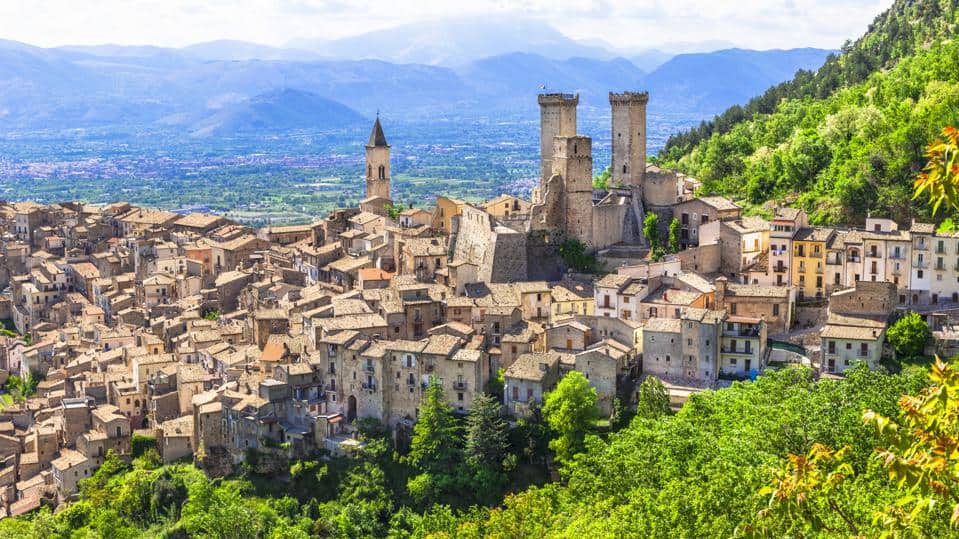
Abruzzo is also the land that preserves the small, authentic villages that are real gems not to be missed during a trip to this beautiful region because they preserve a truly unique historical, architectural, and cultural heritage, which should not only be preserved but also enhanced.
Set among the Apennines or surrounded by green parks, the villages of Abruzzo are wonderful places where time seems to stand still.
10. Abbateggio
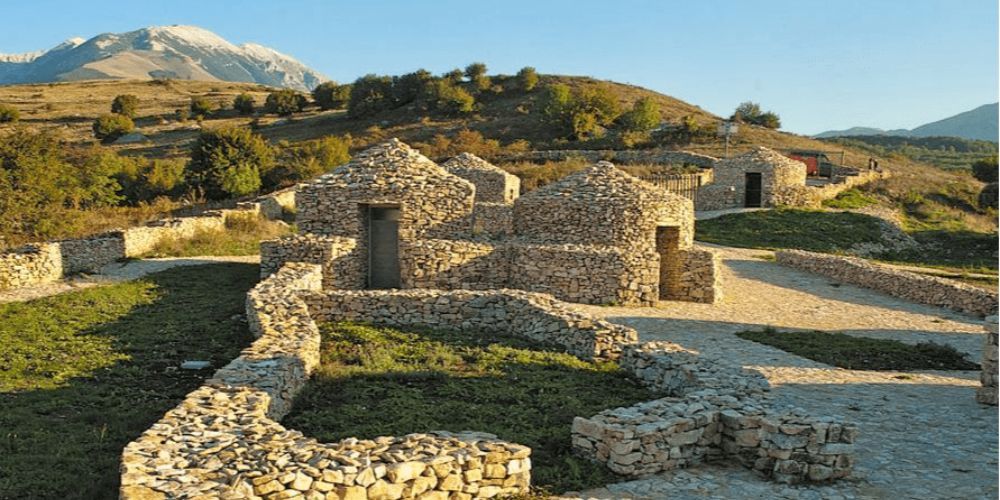
Abbateggio is a municipality in the province of Pescara.
It is a small village on the slopes of the Maiella (the mother mountain of Abruzzo), listed as one of the "Most beautiful Villages in Italy."
Surrounded by greenery and perched on a rocky spur, it had its origins with the Abbey of San Clemente a Casauria, founded by Emperor Ludwig II in 866 in the ancient town of Casauria.
Abbateggio is a village with small houses, made of white local stone overlooking the Fosso Fonte Vecchia valley, characterized by winding streets and steep stairways, from which one can look out over the green views surrounding the town.
In the historic center, corresponding to the site where Abbateggio's castle once stood, there is the Church of San Lorenzo Martire, with its Renaissance facade, 15th-century portal, and Baroque interior.
On a rocky hill opposite the village, with views of the Gran Sasso, the Maiella and Morrone mountains, and the Adriatic Sea, there is the Sanctuary of the "Madonna dell'Elcina."
This Church was built on the site where there were some Marian apparitions between the 15th and 16th centuries, assuming a considerable religious value for the entire valley.
Under the altar there is a trunk of an elm (holm oak) considered to be a remnant of the tree on which the Virgin appeared, while near the altar there is a painting depicting the Madonna in a red tunic and blue mantle, sitting on a tree, holding the Child in her arms.
According to popular devotion, the painting is the same one that Our Lady gave to the two shepherd children to whom she appeared.
Abbateggio is also rich in archaeological sites, such as the Valle Giumentina site, one of the most important Lower and Middle Palaeolithic sites in Abruzzo, where a group of "tholos" huts, dry stone structures built by shepherds and farmers as shelters, can be admired.
Other archaeological sites have emerged in "Contrada Sant'Agata" and at the "Col di Gotte" crossroads.
In the former, the votive altar of a small early-medieval church, to which women devoted to Saint Agatha went to ask for fertility and an abundance of milk was brought to light.
In the second site, fragments of statues of great importance were found. Among these, the lower part of a bust, in whose six-fingered hand the God Hercules can be recognized, to whom the sanctuary now being re-emerged may have been dedicated.
It is a village with many possibilities for excursions on foot or with a mountain bike, also suitable for climbing, due to its location in the Maiella National Park.
Gastronomy also has its charm in a village full of traditions.
In Abbateggio, to be rediscovered among the peasant seeds is the "Spelt", the ancient food of the Egyptians and other Mediterranean peoples, whose cultivation remains in limited mountain areas with cold, calcareous soil.
9. Caramanico Terme
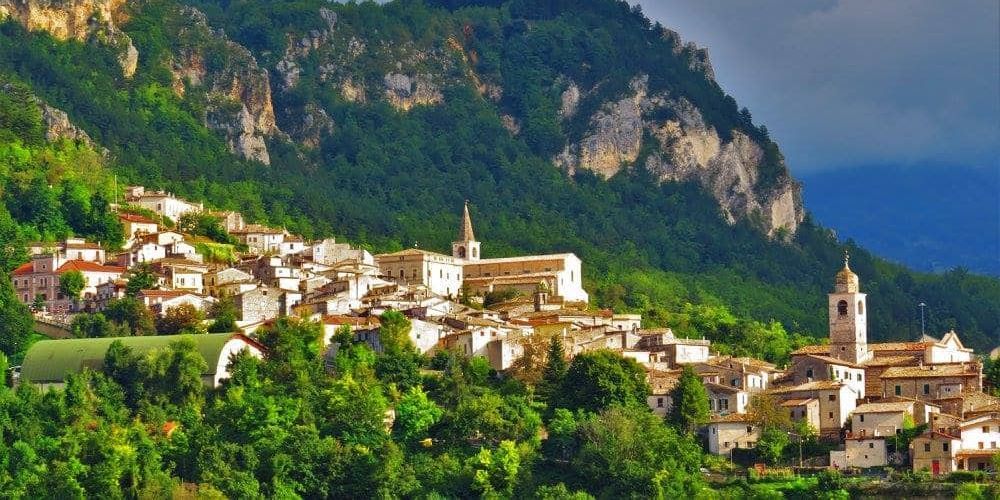
Situated at an altitude of 650 meters, in the heart of the Maiella National Park, Caramanico Terme is a municipality of Lombard origin that still retains its medieval layout with the remains of houses, walls, ancient gates, and a charming maze of alleyways all around the town and is enriched by some imposing mansions built during the Renaissance.
It is famous for its state-of-the-art spa center. It is a very popular destination that boasts the presence of two special waters, one sulfurous with anti-inflammatory properties and the other oligomineral with diuretic properties.
The presence of these beneficial waters has led to the creation of a thermal center where treatment and prevention activities and services dedicated to personal well-being are carried out.
This village is ideal for a relaxing holiday, but it is also perfect for hiking enthusiasts since from its historic center many paths allow you to explore the Orfento Valley.
The Orfento nature reserve is an area of the Apennines where wolves, Marsican bears, deer, roe deer, and chamois still live. It is not uncommon to see the golden eagle circling in the sky in the silence broken only by the flowing waters.
Hermits and monks have found their places of ascesis here, founding churches and hermitages set in the rock of the Maiella, such as the Hermitage of San Giovanni, which is more difficult to access, located at 1220 meters in a scenic spot in the Orfento valley.
The descent leads to Decontra, a small hamlet with a core of stone houses. The view from here is marvelous: Monte Morrone and the north-western slope of the Maiella divided by the Orta valley.
In this small village, too, you can savor delicious dishes that recall the simple but tasty cuisine made up of traditions and scents that cannot be found elsewhere, such as pasta "Alla Chitarra" with lamb sauce or cheeses accompanied by black pork and wild boar salami.
8. Pescocostanzo
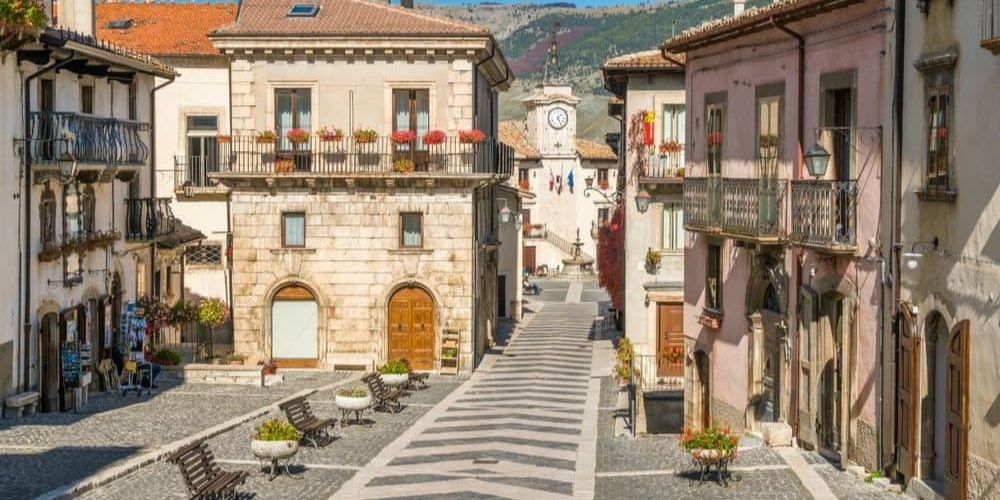
Located at an altitude of 1410 meters in the Maiella National Park, a strange mountain with large canyons, rock walls, and dense forests in the valleys, Pescocostanzo is a village of extraordinary beauty.
The town boasts a really unique architectural, historical, and religious heritage dating back to the medieval period and is one of the "Most Beautiful Villages in Italy."
Walking through its streets, you can admire masterpieces such as the Church of Jesus and Mary with the adjoining Franciscan Convent, Palazzo Sabatini, and the Collegiate Church of Santa Maria del Colle.
The village is also famous for having a long tradition of handicrafts creation such as carved wood and wrought iron items, filigree jewelry, and bobbin lace. Some of the women of Pescocostanzo still sell their precious bobbin lace directly to their homes, even from drawings.
Between Pescocostanzo and Cansano lies the "Bosco di Sant' Antonio", one of the most beautiful beech woods in Abruzzo.
Protected as a Nature Reserve since 1985, the wood contains numerous centuries-old plants, maples, wild pear trees, yews, turkey oaks, and cherry trees. Gentian, peony, and one of Italy's rarest wild orchids, "Pipactis Purpurea" bloom in early summer.
Pescocostanzo is part, together with Roccaraso and Pescasseroli, of the most important ski area in Abruzzo, which attracts many winter sports enthusiasts every winter.
In the winter, it is possible to go cross-country skiing among the beech trees and on the plateau below, while summer lends itself to walks and picnics.
7. Santo Stefano di Sessanio
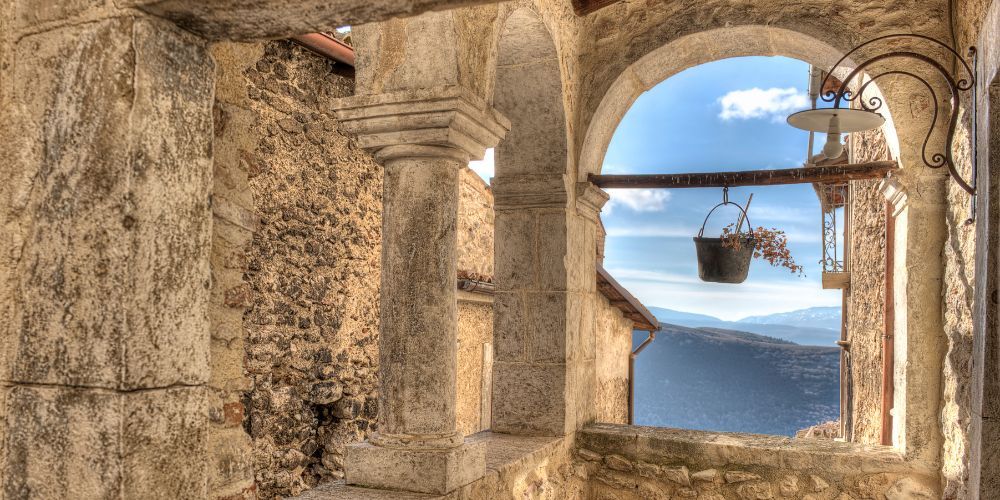
Santo Stefano di Sesssanio is a charming medieval village located at an altitude of 1250 meters in the Gran Sasso and "Monti Della Laga National Park."
It was part of the Campo Imperatore- Piana di Navelli mountain community.
Among the "Most beautiful villages in Italy," it is undoubtedly a destination not to be missed during a trip to Abruzzo.
The current urban conformation of the village dates back to the Middle Ages, is part of a process in Abruzzo that sees the birth of small fortified towns in places not easy to reach to defend themselves from enemy invasions.
For this reason, it is defined as a real jewel set in the mountains.
The village, built between the eleventh and twelfth centuries and dominated by the powerful Medici family at the end of the sixteenth century, is a magical and timeless place where silence, high altitude, an enchanting landscape, and the beauty of the old town center welcome you.
Walking through Santo Stefano di Sessanio, among houses and streets built in white limestone, made only a little more opaque by the passing of the centuries, it seems like taking a trip back in time,
the tile roofs create a harmonious vision for those who look at the village from above.
This small village attracts many tourists who love culture and nature, ideal for those who love sustainable tourism.
There are many cultural initiatives in collaboration with organizations, institutions, and museums from all over the world, with the main attractions of the place being the Medicean Tower, which is presumed to have existed before the arrival of Francesco de' Medici's family.
Restored after it collapsed during the 2009 earthquake, it was returning to the community in April 2021.
In "Piazza Medicea" stands the Chapel of Santa Maria Delle Grazie or del Carmine, whose high altar houses the statue of the Blessed Virgin Mary of Carmine.
In the center of the village, you can admire the palace that was built as a stately residence by the Medici, called "La Bifora" or Palazzo del Capitano.
Finally, don't miss a visit to the Chapel of the Madonna del Lago, located just outside the village, near the small lake of Santo Stefano, from which there are nature and ski trails.
What most represents Santo Stefano, however, is the "Lentil."
It is a product of the highest quality, which is grown only in the arid soils of the high mountains.
Excellent to taste, the lentil is the basis of traditional dishes that tell the story of this area, writing it in the flavors and ancient gestures of the kitchen, which has become a Slow Food presidium.
6. Tagliacozzo
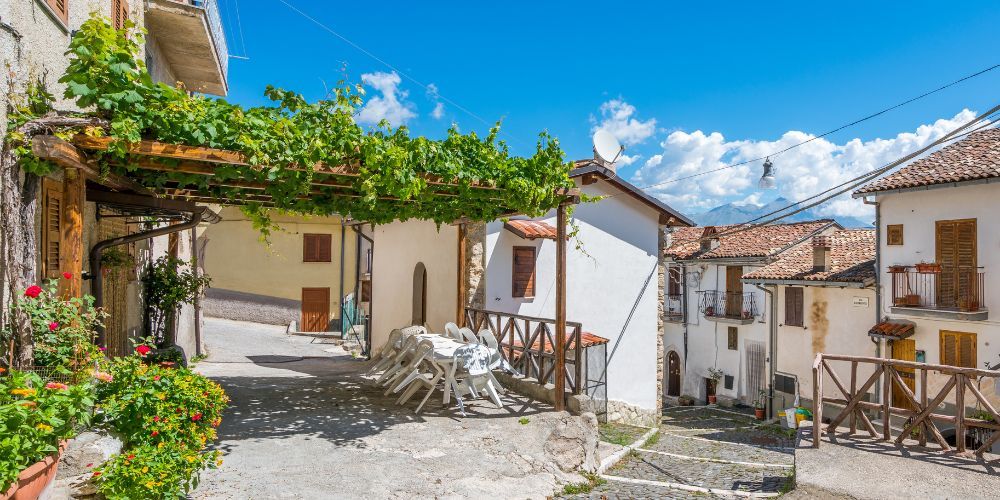
Tagliacozzo is a destination in the province of L'Aquila, in the western part of the Marsica region, lying on the slopes of Mount Civita. It is rightfully one of the "Most Beautiful Villages in Italy," thanks above all to the integrity of its ancient part.
It is a place rich in history, dating back to the Middle Ages, with a marvelous square at its center, one of the most harmonious and scenic in central Italy, from which narrow streets lead off, giving the feeling of going back a few centuries.
To grasp the essence of the town, it is necessary to arrive in its ancient heart: beyond the Roman arch, where houses, palaces, churches, alleys, and streets meet in a concentration of traditions and typicality.
Tagliacozzo has a history made of great episodes: here Corradino di Svevia was defeated by Carlo D'Angiò and this is also mentioned by Dante in the XXVIII "Canto dell'Inferno."
It also boasts a priceless cultural and historical heritage, from the Sanctuary of the Madonna dell'Oriente situated on a hill at the foot of Monte Aurunzo, to the Church and Convent of San Francesco with its beautiful facade and ancient portal and Gothic rose window, which houses the tomb of Blessed Tommaso da Celano, the first biographer of Francis of Assisi.
The oldest complex, rich in memories, is the Church and Monastery of Saints Cosma and Damian, which houses a painting known as the Holy Face.
Finally, the Oriental Museum, which displays Egyptian, Oriental and Ethiopian antiquities, should not be missed. Among the votive offerings is an 1856 painting ordered by the entire population of Tagliacozzo in thanksgiving for the end of the cholera epidemic.
The pearl of Tagliacozzo's artistic heritage is the Palazzo Ducale, which has two architecturally very different floors, one in Gothic style, the other in Renaissance style.
The center of social life is the Piazza Obelisco, to the east of the old town. This is surrounded by elegant buildings with a lovely loggia with Renaissance windows, in the center of which is a fountain with an obelisk.
Many events characterize the town's cultural activity throughout the year, such as the Festa del Volto Santo (Holy Face Festival), celebrated annually on the Sunday after Easter, the Renaissance festival in honor of Ascanio Mari in July, and the prestigious International Midsummer Festival in August.
You cannot leave Tagliacozzo without tasting the "gnocchetti" with chickpeas, polenta with sausages served in "sciffellette" (wooden plates), lamb with cheese and eggs, salami, ham, bacon, guanciale, loin of pork, coppa and livers.
In Tagliacozzo you can taste, also, delicious desserts such as almond macaroons, chocolate mostaccioli, aniseed biscuits, doughnuts with wine or sugar icing, and jam-filled "barachiglie."
5. Scanno
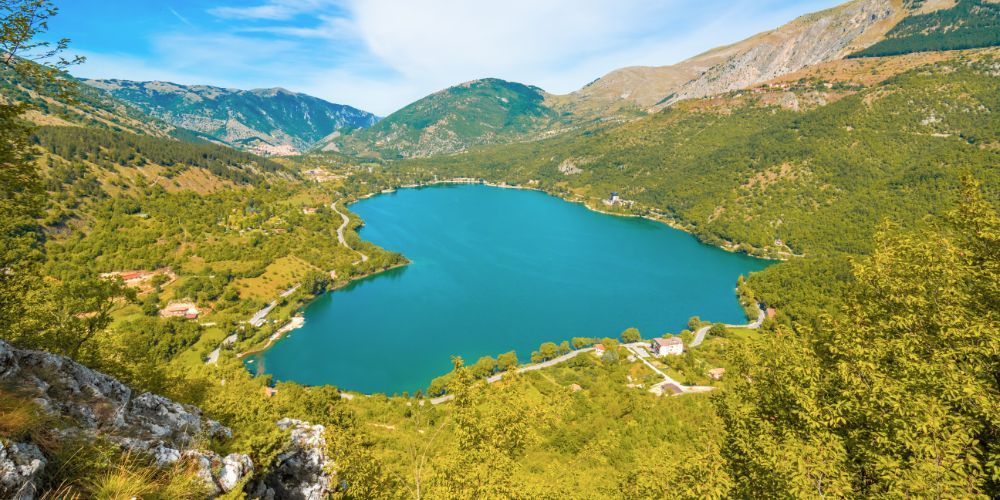
The village of Scanno is an authentic gem set in the Abruzzo, Lazio and Molise National Park, at 1050 meters above sea level. Lake Scanno, which is located in a natural basin surrounded by the Marsicani mountains, is a Blue Flag and is the largest in the region as well as being one of the most beautiful. It is suitable for swimming, which makes it a very popular destination in the summer and its heart shape makes it even more fascinating.
On its shores is the suggestive Sanctuary of the Madonna del Lago, while in the surrounding area there are several trekking and biking trails for a true full immersion in the lush nature of this wonderful park. One of the most popular trips for those who visit Scanno, for example, is to the nearby Gole del Sagittario.
The heart of the historic center of the small village is the Romanesque Church of Santa Maria della Valle; the main square is that of San Rocco, with its elegant buildings, but the streets and alleys that intertwine with each other are an equally unmissable sight. Scanno is full of shops selling typical products, both food and non-food. The goldsmith shops stand out for their number and the mastery of the artisans.
Equally typical are the so-called cemmause, the entrance stairs to the buildings that are a characteristic of the village. Also not to be missed is the important Wool Museum that tells the story of one of the major artisan activities of the place.
A walk in this charming village is a real journey into beauty, in fact it is no coincidence that Scanno is also called the city of photographers because over the years it has been able to enchant Italian and foreign authors. A famous photograph of Scanno, by Mario Giacomelli, is kept at the MOMA in New York.
4. Civitella del Tronto
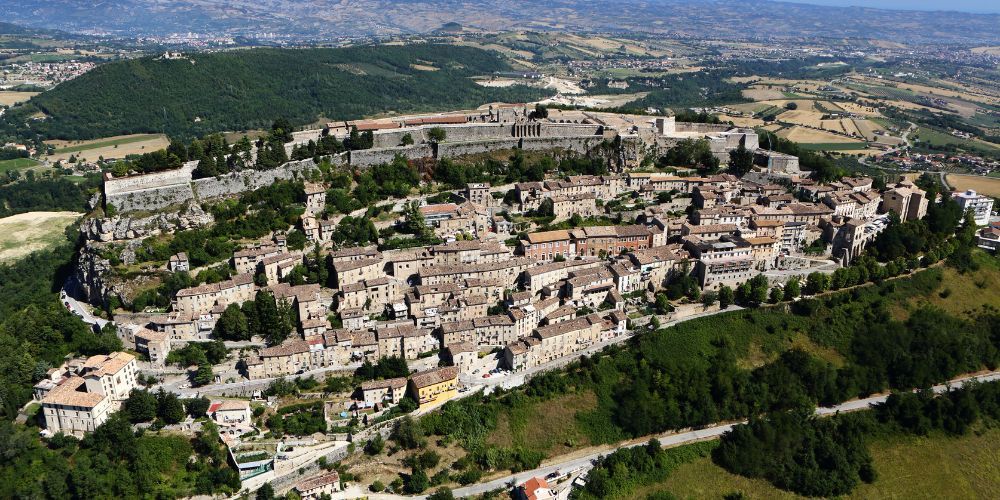
Not only among the most beautiful villages in Abruzzo, but also among the most beautiful in Italy, Civitella del Tronto, in the province of Teramo, is perched on the side of a large granite rock.
It is a small village, but a large 11th-century fortress watches over it, which helps create a truly unique view for those arriving from outside. From Piazza Pepe, the main square of Civitella del Tronto, instead, you can admire a beautiful panoramic view of the valleys and hills, with the mount Gran Sasso in the background. The square is also home to the Palazzo del Podestà and the church of San Lorenzo.
Corso Mazzini is the main road and leads to the Town Hall. The building was originally a convent and in fact you can easily notice it from the shape of the entrance portal and the bell tower, transformed into the Civic Tower. Not far away is the church of San Francesco, which was also once part of the convent.
Among the most famous buildings in the village is also Palazzo Ronchi, which is notable for its particularly narrow shape, which occupies a narrow space between two alleys. Not to be missed in Civitella del Tronto, the large fortress which, with an extension of twenty-five thousand square meters, is among the largest military buildings in Europe. Inside there are an infinite number of spaces to explore, from cisterns to parade grounds, museums, stables and so on.
Civitella del Tronto also holds another unusual record. In this village there is also the narrowest street in Italy, called Ruetta, which measures only forty centimeters in width.
3. Pescasseroli
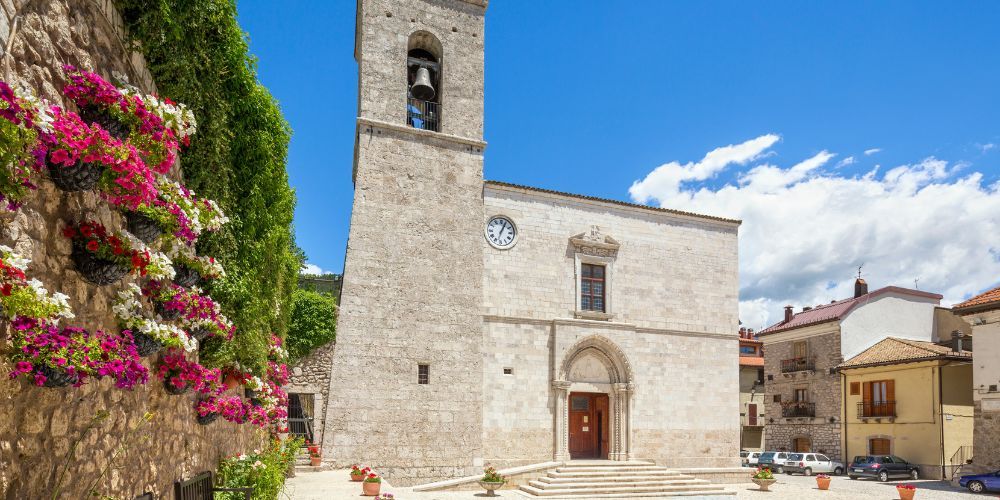
Among the most beautiful villages in Abruzzo there is undoubtedly also Pescasseroli, the heart of the Abruzzo National Park. Given its position, this village is the ideal starting point for beautiful summer walks within the park, but also for a winter vacation, since it is the epicenter of the Alto Sangro ski area which includes more than two hundred kilometers of downhill or cross-country slopes.
The origin of the village is ancient and according to a popular legend linked to the unhappy love of the knight Serolo and the beautiful girl Pesca. The name of the village would therefore derive from the union of the names of the two lovers separated by the cruelty of a count jealous of the girl, who then founded the village on their tomb to atone for his sin. According to scholars, however, the name probably derives from the Latin pesculum serulae, meaning "sheer rock" and in fact the oldest nucleus of Pescasseroli is located under a rocky spur. Here you can also find the ruins of Castel Mancino, one of the attractions of this area.
Pescasseroli is still a beautiful village to explore for its serene atmospheres and for the beautiful white paved streets and flower-filled windows.
Among its most important monuments is Palazzo Sipari, a beautiful neoclassical building with four floors, where one of the greatest Italian philosophers, Benedetto Croce, was born. The church of San Pietro and Paolo, the oldest and most important in Pescasseroli and dates back to the 9th century. Much more recent, the church of Carmelo dates back to the 18th century but is no less fascinating.
Furthermore, from the highest part of the village you can admire beautiful views of the surrounding landscape which is characterized by a lush and ancient nature. The beech forests of this area have been a UNESCO heritage site since 2017.
2. Pacentro
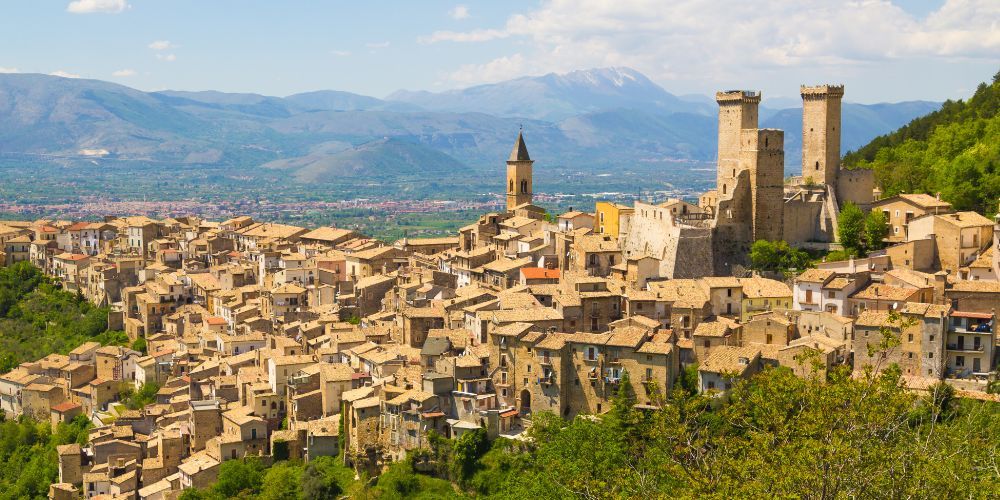
Pacentro is a small mountain village, surrounded by the lush nature of the Majella park. Not far from Monte Amaro, the highest of the Majella mountain range, this village offers wonderful views and also the opportunity for beautiful walks.
The medieval historic center is well preserved and this makes it a place of great charm. The village developed around the centerpiece of the castle, a beautiful Norman fortress from the 11th century and among the best preserved in the region.
Walking through the charming streets, then, it will be easy to come across churches, palaces and you will certainly reach the main square, Piazza del Popolo. Here is the fifteenth-century church of Santa Maria Maggiore, while not far away there is the elegant Palazzo Rocca, home to the Town Hall and the Civic Museum.
The oldest church in Pacentro dates back to the 11th century, it is the small church of San Marcello. Also not to be missed is the Church of San Marco, while for an immersion in the daily history of the village there is Casa Marlurita, an ancient medieval house that today preserves objects and furnishings from the nineteenth century.
1. Sulmona
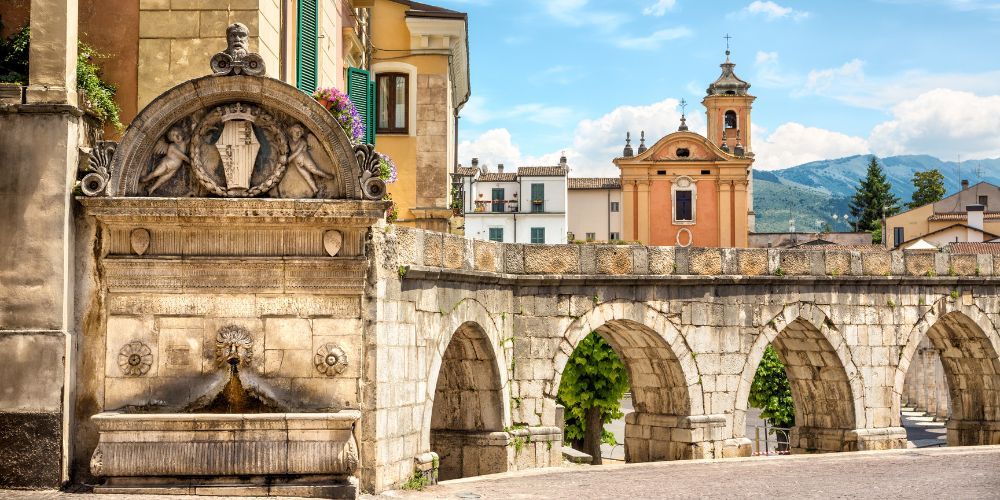
A tour of the 10 most beautiful villages in Abruzzo cannot fail to include Sulmona. This small town is located in the center of Abruzzo, surrounded by mountains and boasts an ancient and illustrious history that has left it a rich heritage. Its streets derive from the Roman layout of the 1st century BC and one of the most famous Latin authors, Ovid, was born here, to whom the main street of Sulmona is dedicated.
In the centuries to come, the nobles of Swabia and Anjou and Aragon lived here. The former were the patrons of the large Porta Napoli, for example, the most important of the six ancient gates of the city that have survived to this day, but also the monumental medieval aqueduct located in Piazza Garibaldi, the main square of the city. Right in this square, the heart of Sulmona, there are also three important churches and a famous fountain.
Other unmissable monuments of the village are the 13th century church of Santa Maria della Tomba and the Church of SS. Annunziata, flanked by the beautiful fourteenth-century palace that today houses the Civic Museum. Just outside the historic center is the Cathedral of San Panfilo, surrounded by the greenery of the Villa Comunale. The saint is also the patron saint of Sulmona and his relics are kept in the cathedral.
Sulmona also has a specialty that makes it even more unique. Its colorful confetti are a local specialty famous throughout the world. Pastry artists prepare hundreds of them, in many flavors, and assemble them to form real sculptures. Walking through the streets of Sulmona you cannot help but be enchanted by these small works of art and of course by their sweet taste.
Abruzzo: where the sea embraces the mountains
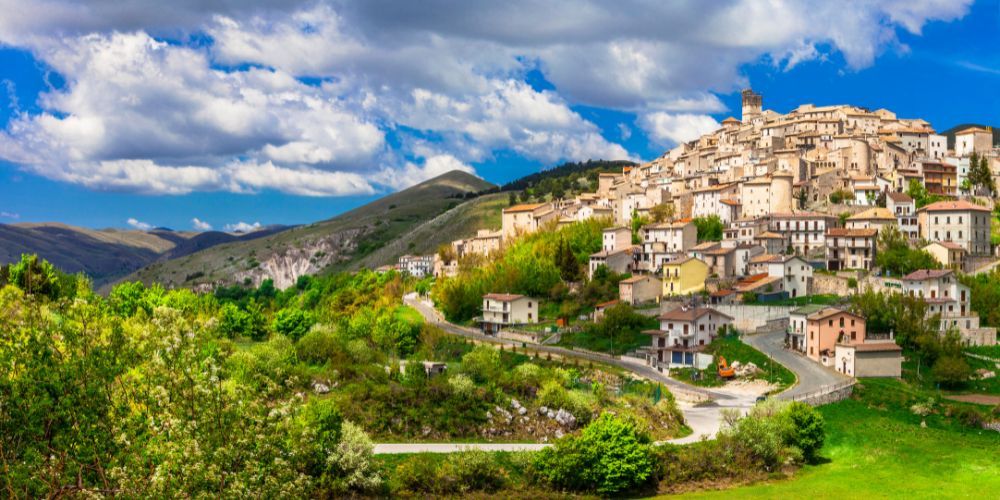
Abruzzo is a unique territory in the world that offers breathtaking landscapes. Land of sea, mountains and lakes. Among ancient villages, castles and nature, from the high peaks of Gran Sasso and Maiella, to the beautiful beaches.
With its lively seaside resorts, with ancient cities rich in history and the high peaks of the Apennines it offers a variety of landscapes combining different traditions and emotions. It is no coincidence that the coat of arms of Abruzzo is an Italian shield divided into bands of three different colors: white like the snow-capped mountains, green like the hills of the hinterland and blue like the sea.
Its position and its climate make it a region that can be visited 365 days a year, not to forget, finally, the long food and wine tradition of the region that ranges from "arrosticini" to fish "brodetto", from Sulmona confetti to soft nougat with L'Aquila chocolate.
What are you waiting for? Come and discover the most beautiful villages in Abruzzo and their culture!
About the author
Written on 22/08/2021


Marialuisa Monfreda
A tour through the culture and history of the 10 most beautiful villages in Abruzzo. Savour the traditions of these timeless places